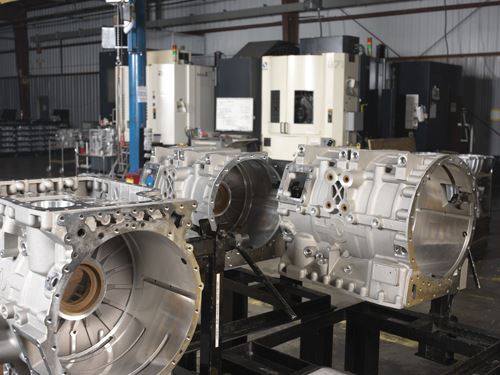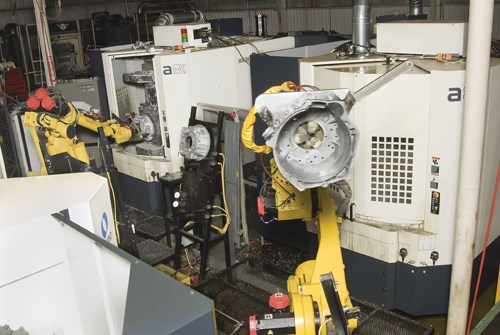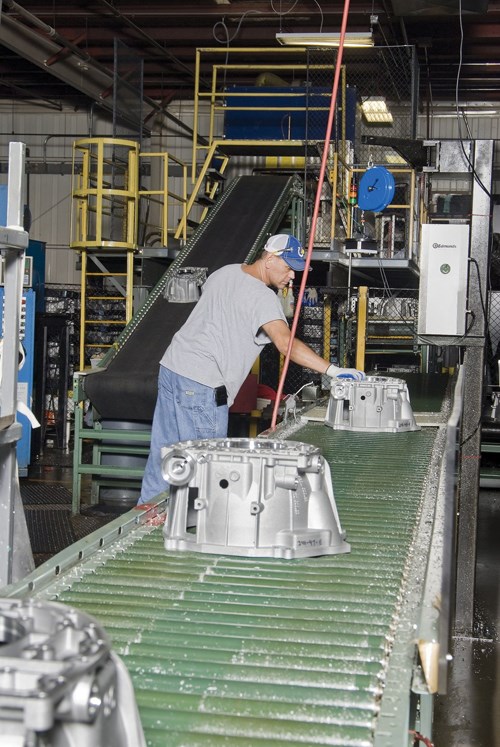Don’t touch the part.” That phrase sums up how Metal Technologies keeps up with overseas competition in the production of automotive components, says company owner Doug Conrad. Although automation is nothing new to manufacturers serving that industry, adhering to such a philosophy requires an especially extensive commitment to taking labor out of the process. At this production machine shop, larger lines run 24/7, and components move from raw material to finished part with little more human intervention than routine maintenance.
Still, the success of the company’s recent investment in four robot-fed a81 HMCs from Makino (Mason, Ohio) demonstrates an important point: automation alone, no matter how extensive, can go only so far. Any process is only as effective as the equipment that executes it, Mr. Conrad explains. “It’s not as simple as putting a robot in front of a machine,” he says. “We need machines that can leverage the full capabilities of an automation system. They need to minimize every instance of out-of-cut time while offering the flexibility necessary to produce a range of part materials and features. Without our Makino a81 HMCs, we simply couldn’t work as fluidly or efficiently.”
Not that long ago, Metal Technologies wouldn’t have considered a machine like the a81. Located near Bloomington, Indiana, the company got its start in 1996 as a fabrication operation to support sister company Bedford Machine & Tool. In 2005, it purchased a 130,000-square-foot facility to support a growing portfolio of automotive work, and it moved into high-volume production machining during the next few years. Today, the 67-employee company produces parts such as 6-speed transmission housings for Ford, a job that amounts to approximately 650,000 pieces per year, and front- and rear-frame cross members for GM’s Chevrolet Corvette, a job that amounts to approximately 31,000 pieces per year.
These and other parts are produced primarily on automated machining cells supported by a climate-controlled quality inspection lab. The four recently purchased Makino HMCs are arranged into one such cell with two material-handling robots and a conveyor system. Raw material moves in via a feed conveyor, and the robots use visual recognition systems to pick parts. Once parts are cleaned, the robots send them to the other side of the conveyor for machining. Finally, each part is tested, washed and restacked on the conveyor to exit the cell, all without human intervention.
The cell has brought all the benefits the company has come to expect from a properly implemented automation system. The ability to produce approximately 510 parts per day (about 255 parts for each pair of machines and their accompanying robot) has improved productivity. Part quality has also improved, because automating a process tends to improve its consistency, Mr. Conrad says. Additionally, the cell’s ability to run multiple applications simultaneously has improved flexibility. “To change part numbers is as simple as going to the PLC and telling it you’re going to run another part,” he explains. “Combined with the flexibility of the a81 HMCs, this has enabled us to produce six to eight different part numbers in the same cell on the fly.”
All these benefits can be traced to the fact that the equipment that constitutes the cell possesses the necessary qualities to run fully unattended around the clock, Mr. Conrad says. From the cell operator’s perspective, this starts with Makino’s Professional 5 control software, which integrates the machines with a PLC system and database. Its interface is sufficiently intuitive to enable operators to quickly and easily modify all aspects of the cell, such as interlock switches, hydraulic part clamp control and robot interfaces.
Additionally, the software enables up-to-the-hour production surveys. “If you really want to impress a customer, show them how you can monitor production capacities anytime, anywhere, using a smartphone,” Mr. Conrad says. “With today’s monitoring software, we can send reports to mobile applications that provide us the number of parts we made in the last day or hour, what our average is for the day, and what we’ve made for the last seven days running. Customers can see this data online, too, and that adds to their confidence in us.”
As for the machines themselves, tool-monitoring systems enable the company to accurately predict tool life and detect when drills, taps or other cutters are broken or chipped. Data gathered from these monitoring devices integrate seamlessly with the machine control to alert operators when tools must be replaced. This facilitates reliable, repeatable part production without interrupting cut time or demanding constant operator attention, Mr. Conrad explains.
For lights-out operation, the machines’ ability to self-manage common maintenance activities is critical. For example, coolant and chip flushing requires virtually no operator attention because the interior of each a81 is constructed of slanted and vertical panels. As a result, chips and coolant flush directly under the table into the center chip trough for quick evacuation. Meanwhile, a filtration unit built into the lift-up chip conveyor ensures a constant supply of clean coolant through an eight-nozzle coolant spindle and overhead shower system.
If parts don’t meet specification, the extent to which a shop is automated or the number of parts it churns out cease to matter. For that reason, the Makino cell at Metal Technologies incorporates a number of failsafe mechanisms to reduce the risk of error, Mr. Conrad explains. For example, if someone tries to load the wrong part number on the cell’s feed conveyor, it won’t fit in the fixture. The feed conveyor also includes an electronic failsafe to prevent loading the wrong part line.
Parts also undergo rigorous inspection processes prior to shipping, including on-machine probing, bore-gage inspections, CMM inspections and pressure testing. The quality assurance team also looks visually for casting defects—one of the only times humans are involved in the process. Some lines also use cameras for visual inspection. Finally, pin stamps, bar codes and physical ID marks help ensure traceability through every step of the process.
The implementation of the Makino cell illustrates Metal Technologies’ experience with automating production. Manually testing machine capabilities, developing custom tooling and fixturing that reduce cycle time, selecting error-proofing procedures that maintain accuracy and consistency, and programming robots for seamless integration were all critical to the cell’s success, Mr. Conrad says. He adds that the shop’s own automation expertise was complemented by that of its supplier, which was a deciding factor in the original investment. Of course, all that knowledge would be for naught if the machine tools themselves weren’t up to par.
“There is a lot to automation, but if you stick with it, it will pay off,” Mr. Conrad concludes. “In 2006, we manufactured about 60,000 parts per year. This year, we’re on track to manufacture more than 800,000 parts. The best aspect of this type of automation is gaining complete control of our business without a person ever touching a part.”
































.jpg;maxWidth=300;quality=90)










